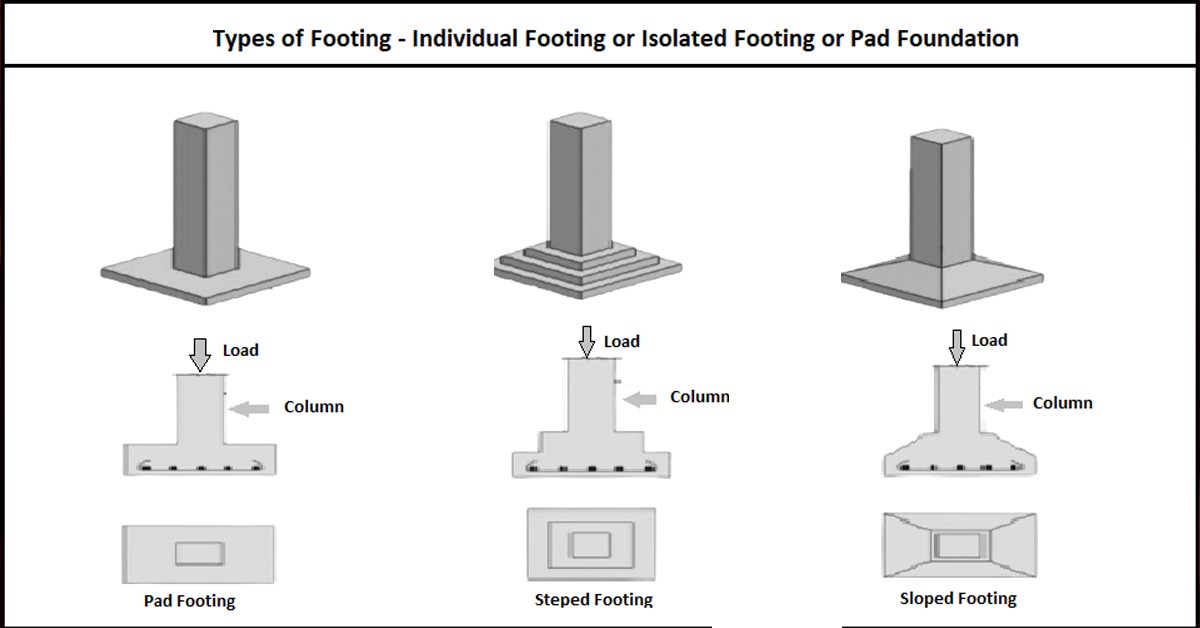Different Types of Footings in Construction
What is footing in construction?
In construction, the term “footing” refers to the foundational elements of a building or structure that support and distribute its load to the underlying soil. Footings are essential for maintaining structural integrity, preventing settlement, and ensuring stability. There are several types of footing in construction, each tailored to specific soil conditions, load requirements, and structural configurations. Understanding the different types of footing in construction is crucial for engineers, architects, and builders.
Types of Footing in Construction
Isolated Footing
Isolated footing, sometimes referred to as pad footing, support individual columns and are typically square, rectangular, or circular in shape. This type of footing construction is used when columns are spaced apart and each column requires a separate footing. Isolated footings are designed to spread the load of the column over a larger area of soil, preventing excessive settlement. They are commonly used in framed structures where the loads are concentrated at specific points.
Combined Footing
Combined footings support two or more columns when the columns are so close that their isolated footings would overlap. This type of footing construction is used when the space constraints or load distribution necessitate a combined solution. Combined footings are often rectangular or trapezoidal and are designed to evenly distribute the loads from multiple columns to the soil.
Continuous Footing
Continuous footing, also known as strip footing, run continuously under multiple columns in a row. This type of footing is used when a row of columns is spaced closely together. Continuous footing construction helps in distributing the loads evenly along the length of the footing, providing stability and reducing the chances of differential settlement.
Strap Footing
Strap footings, or cantilever footings, are used when the columns are close to the property line and there is limited space for a traditional footing. In this type of footing construction, a strap beam connects an exterior footing with an interior footing. The strap beam helps distribute the load from the column near the boundary to the interior footing, ensuring stability.
Mat or Raft Footing
Mat footings, also known as raft foundations, involve a large concrete slab that supports the entire structure. This type of footing construction is used when the loads from columns or walls are so high that individual footings would be impractical. Mat footings are suitable for soils with low bearing capacity and are commonly used in large buildings, industrial structures, and areas with high groundwater levels.
Pile Footing
Pile footing involve driving long, slender columns (piles) into the ground to reach a stable soil layer. This type of footing construction is used when the surface soil is weak or compressible, making traditional footings impractical. Piles transfer the load of the structure to deeper, more stable soil or rock layers. Pile footing is commonly used in high-rise buildings, bridges, and structures on waterfronts.
Spread Footing
Spread footing is similar to isolated footing but are designed to spread the load over a larger area. This type of footing construction is used when the soil bearing capacity is relatively low, and a larger footprint is needed to distribute the load. Spread footings can be square, rectangular, or circular and are commonly used in residential and commercial buildings.
Conclusion
In conclusion, understanding the different types of footing in construction is essential for ensuring the stability and longevity of a structure. Each type of footing, from wall footing to pile footing, serves a specific purpose and is selected based on the soil conditions, load requirements, and structural design. Proper footing construction is vital for distributing loads effectively and preventing settlement, thereby maintaining the structural integrity of buildings and other structures. Check out ARS Steel for premium, cost-effective steel bars that are perfect for footing of all your construction projects.



